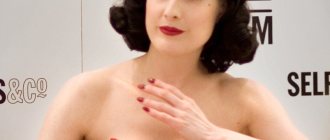Success story of Marlene Dietrich
When director Joseph von Sternberg brought the 29-year-old actress to Hollywood, no one recognized the star of the film “The Blue Angel” in this short, plump brown-haired woman. She was 165 cm tall, with a flat chest, wide hips and an upturned nose.
This German woman did not fit into Hollywood beauty standards. Therefore, it did not arouse any interest from the producers. However, Sternberg knew the art of transformation well, and he had pliable material in his hands.
It all started back in Berlin, when he noticed a girl on the cabaret stage. Unlike other actresses, she showed icy indifference to the Hollywood director sitting in the hall. And then she even dared to twice refuse him to have dinner together.
Before meeting Sternberg, she had already appeared in ten silent German films and gained extravagant fame in the decadent circles of Berlin. From the very morning she could wrap herself in a boa, put on a monocle and walk around the city in very high-heeled shoes, which were in great short supply.
Her legs have been her pride since she was young. Her mother considered thin calves and wrists signs of being “stable.” When the mother thought that little Maria had crooked legs, she forced her daughter to sleep in heavy steel stocks for two years and walk only in tightly laced high boots.
But later the actress showed off only in high-heeled shoes and recognized only such shoes. Maternal concern about her legs brought the future star her first earnings. The girl got a job at a local theater, on stage she lay on her back and spun a “bicycle” with her legs.
Along the way, she starred in advertisements for nylon tights and underwear. Subsequently, her fantastic legs will be insured for $1 million. Not a single film featuring her would be complete without close-ups of her legs.
Marlene Dietrich - biography, “a sultry woman with a spine of steel”
Marlene Dietrich, born Maria Magdalena Dietrich December 27, 1901 - May 6, 1992, was a German and American actress and singer who created one of the perfect cinematic female images.
When starting to narrate the biography of Marlene Dietrich, you can always find yourself in the trap of “double standards.” For there is no more controversial show business star than Marlene Dietrich. No matter which way you start to describe her life, you always run the risk of showing one-sidedness.
If we talk only about scandals, countless love affairs and sexual preferences of Marlene, this will be partly true, but it is not fair to Marlene as an intelligent, deeply sensual person, a selfless, disciplined worker, a devoted friend and simply a good actress. One can only try to bring together these two halves which will reveal the GREAT MARLEN.
Jean Cocteau himself divided her name like an atom inhabited by positive and negative particles: “Her name begins as a gentle touch and ends with the blow of a whip.” One of her friends, the English playwright and writer Noel Coward, once complained. “She could have become the greatest woman of our century, but - alas! “Intelligence does not adorn women!” Smart and educated, read a lot of old and modern authors, knew Rilke's poems by heart, and adored James Joyce, Marlene shocked the American Puritans with her provocative behavior, from their point of view. She smoked constantly, appeared in society in a man's suit, and changed lovers like gloves...
She was born on December 27, 1901 in a small town near Berlin into a military family who participated in the Franco-Prussian War. However, soon, her father left the family, and her mother remarried. Already in childhood, Marlene showed duality of nature: As a child, Dietrich called herself Paul, hoping that she was more like her father than her mother. Until the age of 18, she bore her stepfather’s surname – Maria Magdalena von Losch.
The name Marlene Dietrich appeared when she decided to enter the stage. She made up her pseudonym from the name of the biblical harlot Mary Magdalene, which is what her parents named the future film star at birth. Already as a child, she was known as an actress in the school theater and attended musical concerts. Until 1918 she attended high school in Berlin. At the same time, she studied violin with Professor Dessau. In 1919-1921 she studied music seriously in Weimar with Professor Robert Reitz. I planned to graduate from the conservatory and become a professional musician.
However, a wrist injury ended her hopes of a music career. She returned to Berlin, where she began studying at the Max Reinhart drama school. In the 1920s she began singing in cabaret, and in 1922 she starred in a movie for the first time (the film “Napoleon’s Younger Brother”). Next year, on May 17, she marries film production manager Rudolf Sieber.
Marlene saw him as a man who could help her career. In December 1924, their daughter Maria was born. Unburdened by maternal responsibilities in 1925, Marlene resumed work in theater and cinema. Marlene, 165 cm tall, plump, with a flat chest and masculine habits, did not shine with beauty. She began wearing men's tuxedos and suits.
However, at the same time she exuded sexuality. Famous film director Georg Wilhelm Pabst rejected Marlene for the role of Lulu in the classic film Pandora's Box precisely because of this. “One sexy look, and the picture will turn into burlesque,” he said. Pabst later wrote that Dietrich was too old and too vulgar.
Well, a year later, Marlene played triumphant vulgarity in The Blue Angel, in a collision with which the spirit collapses. No less famous director than Pabst, Joseph von Sternberg, saw her in the revue “Two Ties.” As the master himself would later write: “In that performance I saw Fräulein Dietrich in the flesh... It was the face that I was looking for...”. This face promised everything and more... According to critics, Sternberg “shaken the ocean, and from the waters emerged a woman who was destined to enchant the world.”
He invites her to play the role of Lola in the film The Blue Angel. They become lovers, and the film itself, released in 1930, was a resounding success.
“I was created by von Sternberg from beginning to end. He shaded my cheeks, slightly enlarged my eyes, and I was captivated by the beauty of the face that was looking at me from the screen,” recalled Marlene Dietrich. Marlene Dietrich managed to bring to life the complex image of a woman who had nothing in common with her. Marlene Dietrich herself considered this role, which brought the actress worldwide recognition, a true debut in big cinema. The film was a success all over the world in 1930, but in Germany itself the film was banned by the Nazis. By the way, “The Blue Angel” exists in English and German versions - these are not dubs, but two different films, and the plot and dialogue are slightly different.
Shooting 2 different versions of a film in different languages was common practice at the time. On April 1, 1930, literally immediately after the premiere, Marlene Dietrich left Berlin, since back in February she had signed a contract with.
Dietrich and von Sternberg went to Hollywood, where together they shot a series of wonderful films: “Dishonored”, “Shanghai Express”, “The Bloody Empress”. Sternberg carefully cultivated Marlene's masculine appearance.
As he wrote: “I saw her wearing a man's suit, a tall hat and the like back in Berlin, and that's exactly how I showed her in the film Morocco, Marlene's first American film. For this role, Marlene received her only Oscar nomination.
And the scene where Marlene, in a tailcoat, top hat and with a cane, sings a French song on behalf of a man and casually kisses a woman sitting at a table. This was already too much for the American puritans. But the Hays Code of Ethics, adopted in 1930, with its draconian methods of banning anything sensual from American cinema, was only gaining momentum. And the scene was not cut. Otherwise, world cinema would have lost one of its best pearls. The tailcoat from the film and the top hat became Marlene's calling card.
She wore men's clothing items with great charm. None of the men could resist. Shtenberg, being married, was very jealous of Marlene’s film partners, for example, Harry Cooper, who starred with Marlene in “Morocco.” In general, Marlene’s personal life has always been ambivalent. Until the death of her husband Rudolf, Marlene needed this game: as if she had a legal spouse. Having been married to the same man since 1923, Marlene remained married to him until his death in 1976.
In reality, she lived with her husband Rudolf Sieber for only five years, but for the rest of almost half a century she was officially listed as his wife. This was an excellent hiding place for the morality commission. The Hays Code was gaining momentum. Marlene never remained faithful to Schnenberg. And he himself, when his wife invited him to marry Marlene, said with a shudder: “I’d rather go into a telephone booth with a cobra.”
After “Morocco” Marlene gained all-American fame. After much persuasion, Marlene convinced her husband to give her his only daughter, Maria. However, despite Marlene’s later assurances in her memories, she was a bad mother. The girl is frightened by the frequency and speed of Marlene’s transformations in life. From the caring housewife and exaggeratedly affectionate mother she is when she leaves home in the morning, she returns in the evening, arm in arm with von Sternberg, as a capricious, lips-pursing lover, and at night in Madame Dietrich’s restaurant, in an embarrassingly bold outfit, she flirts with all the men in a row. The next day, newspapers publish playful photographs of her with Maurice Chevalier, John Barrymore, Douglas Jr., the first Hollywood cowboy John Wayne... She was credited with a love affair with her good friend producer Joseph Kennedy, the father of the future President of the United States.
Marlene commented on this relationship as “family friendship.” This woman always knew how to get away with it. For example, she had an affair with John Gilbert, the former lover of Greta Garbo, whom the latter almost married, but ran away at the last minute. Marlene was with the actor in the last two years of his life. Gilbert suffered from seizures (a consequence of drinking) and died of asphyxiation on January 9, 1936, at the age of 36.
Dietrich was with him when this happened, but, realizing that the poor man was dying, she ran away - such a tragic episode could have had a very bad effect on her career. She ordered the servants to destroy all traces of her presence in the bedroom. I called the doctor. She looked with sadness and shudder at the face of deceased John and disappeared from the apartment. At Gilbert's funeral, Marlene fainted.
And once a week, Dietrich, as an exemplary wife, calls her legal spouse and father to Berlin with her daughter to report on what is happening. Their relationship was very strange. Marlene's husband lived with Russian emigrant Tamara Krasina. And Marlene even rented a house for them.
Years later, the daughter would take revenge for her mother's callousness by releasing her memoirs, My Mother Marlene, in which she presented her as a worthless and vain libertine. Many claimed that Maria was driven by envy, because her daughter’s film career did not work out. But, for sure, her memories are not without some truth. It is difficult to imagine a good mother who leads such a lifestyle. Changing men like gloves. Some who knew Marlene personally claimed that after the release of her daughter’s memoirs, Marlene did not want to live.
But for now it’s the 30s of the 20th century. Marlene falls in love with 40-year-old screenwriter Mercedes de Acosta. At first, she did not reciprocate, and Marlene began to literally shower her with flowers.
Every day she sent her dozens of white roses and red carnations. Their connection, which they did not hide, continued throughout almost the entire 30s of the last century. This, however, did not stop Marlene from having new male lovers. So, at some point she became infatuated with the young actor Kirk Douglas. Many details of Dietrich’s sex life became known after her diary was discovered in 1992, in which the names of her lovers and the dates of meetings with them were encoded. Marlene, as many of her partners testify, was not particularly energetic in bed. But Marlene dressed in men’s clothes several times a month and visited lesbian and transsexual clubs in Los Angeles.
The famous director Fritz Lang clearly expressed himself about such a frequent change of partners: “When she loved a man, she gave him all of herself, but at the same time she continued to look around. This was the main tragedy of her life. She probably had to constantly prove to herself that one lover can always be replaced by another.”
After the triumph, Morocco staged the premiere of the English version of The Blue Angel, and Sternberg in a short time made three films with Marlene: Dishonored (1931), Shanghai Express (1932), Blonde Venus (1932). The last picture was a fiasco, which forced Paramount to search for a new director for Dietrich.
It was Ruben Mamulyan. In his “Song of Songs” (1933), based on the novel by Suderman, Marlene again played the role of a prostitute. Meanwhile, Sternberg returns to the studio. In the film “The Red Empress” (1934), Dietrich creates the image of Catherine the Great. The most impressive episode of the film is the wedding scene. It lasts five minutes without a single word, only music sounds.
In the early spring of 1934, Marlene visited Berlin, where she left her mother and sister. On the way back, the actress met Ernest Hemingway, who became one of her best friends. Later, she would even act as matchmaker in his marriage to journalist Mary Welsh, known as Mary Hemingway. The writer himself said that Dietrich “was capable of destroying any rival without even looking in her direction. The affair with Ernest Hemingway lasted almost 30 years, and in this affair there was more friendship than love.
They both didn't believe in loving each other. Marlene believed that Ham loved other women, and Hemingway believed that she also preferred others - Gabin and Chaplin. Both admired each other: Ernest Hemingway - Dietrich's beauty, and she - his novels; By the way, in “Islands in the Ocean,” Ham portrayed the heroine-actress, clearly based on Marlene Dietrich. And Marlene also understood that they could not be together as husband and wife. She wrote: “He needs a hostess who would look after him, serve him coffee, and in the morning I have makeup, a pavilion, filming…”.
Meanwhile, Sternberg announced that he would be making his last film starring Marlene. According to people who knew the creative couple Sternberg and Dietrich closely, the film “The Devil is a Woman” (1935), based on Louis’s novel “The Woman and the Puppet,” had a pronounced personal character.
The proud Conchita's struggle with Don Pascal captures the complex love-hate relationship that existed between the director and actress. Dietrich considered this film her best film work. Marlene's first film after her breakup with Sternberg was called Desire (1935). It was directed by Frank Borzage. According to The Times, the result is “a romantic comedy full of kindness, cleverness and charm. And Marlene Dietrich played her best role in it...” However, these films became such a commercial failure that Dietrich was called “a ticket office with poison.”
This forced the actress to leave Paramount in 1936. Having learned about this, the famous producer Selznick offered her a “fabulous fee”, which, according to him, he would never pay to anyone - 200 thousand dollars. And although Dietrich absolutely did not like the script for the film “The Gardens of Allah,” she fulfilled her contract professionally. After which she left for Europe, where another producer Korda was already waiting for her with the largest fee of her entire life - 450 thousand dollars (7-8 million at the current exchange rate).
Dietrich starred in an exciting romantic film based on Hilton’s novel “A Knight Without Armor.” True, she never managed to receive the entire fee. Paramount management makes her an offer she can’t refuse: $250,000 per film plus bonuses. She is starring in “Angel” with Lubitsch.
The film starring the queen of the screen brings in such meager receipts that the “highest paid woman in the world” finds herself out of work. Marlene was Hitler's favorite actress. At the end of 1936, she receives an invitation from the Nazis to return to her homeland.
But Dietrich responded with a categorical refusal, and since then her films have been banned in Nazi Germany. On March 6, 1937, she accepted American citizenship.
In September 1937, Marlene Dietrich met the writer Erich Maria Remarque. Dietrich goes to Paris, where he spends time in the company of a German writer. Marlene persuades him to go to the USA.
Remarque was safe in America, but homesickness and fear for his loved ones who remained in Germany haunted him. The writer dedicated the novel “Arc de Triomphe” to his difficult relationship with Marlene, whom he called Puma, in which she is depicted in the image of the restless actress Joan Madu.
Surprisingly, in Marlene’s autobiographical book “Just Take My Life...” you will not find a single mention of Remarque, who maintained a very close relationship with Dietrich for several years.
Another story that is incredibly intriguing to many film lovers and film scholars - the story of Jean Gabin - is presented in the same book as if it did not mean very much in the life of the actress. Meanwhile, her most striking romance in the Old World was her relationship with the famous French film actor Jean Gabin.
Here Dietrich seems to have fallen in love. He called her “my little Prussian,” and she tapped him on the forehead, saying: “Why I love this place is because it’s empty!” She was even going to give birth to a child from him, but when Gabin decided to join the French Resistance forces, she had an abortion.
Marlene had not acted for two years, and many felt that her career was close to sunset. However, the actress returned to Europe, where she starred in the western “Dextry Is Back in the Saddle” (1939), where James Stewart played opposite her, and criticism again excitedly praised Marlene to the skies.
Producer Pasternak made several more films with the participation of Marlene: “Seven Sinners”, “New Orleans Light” (1941), “Gold Diggers” (1942), “Pittsburgh” (1942) ... These films brought good profits to Universal. When World War II began, she felt "as if she were responsible for the war that Hitler started."
Dietrich conducts active anti-fascist propaganda, tours America to sell bonzes - war bonds, visits factories, urging workers to make donations. What was dearest to her was the image of Marlene the soldier.
She made military uniforms at Sachs's fashionable Fifth Avenue and in 1944 traveled to North Africa and Italy as part of an American concert troupe.
She takes pictures with the soldiers, dances with them, wears a military uniform and helmet. She is given army tags and an identification card. On the “dressing” tent there is a sign with a menacing inscription: “Entry is prohibited! Secret... Dangerous... Marlene Dietrich's dressing room." The actress became the first woman to receive the Medal of Freedom in the United States; in France she was awarded the Legion of Honor, and in Israel she was awarded the Medal of Courage.
Anyone who listened to Marlene Dietrich's stories about her front-line concerts got the impression that she really spent at least four years in the army, in Europe, and all the time on the front line, under constant fire, in danger of life, or something else worse, with the danger of being captured by the vengeful Nazis. Everyone who listened to her was convinced of this, because she herself convinced herself that everything was exactly like that. In reality, with all the comings and goings, Dietrich was in Europe from April 1944 to July 1945, and between concerts she flew to New York, Hollywood, and then lived either in Paris or at the headquarters of her beloved general in Berlin. This in no way diminishes Dietrich’s commendable civic contribution to the cause of Victory, but only allows us to see everything in its true light. She truly was a fearless, heroic, dedicated woman. But many women, military personnel and pop artists possessed the same qualities, but they were not awarded the Order of the Legion of Honor of all three degrees and medals of Freedom.
Dietrich played the role of a brave soldier much better than them, and her fame and beauty attracted attention to her. In the winter of 1944 in France, Dietrich begged a jeep from a sergeant and rushed in search of Gabin, who served in tank units.
Their meeting was short-lived. In small photographs, Marlene and Jean are depicted in military uniform, very tired, but happy.
After his death in 1976, Dietrich told newspapers: “Having buried Gabin, I became a widow for the second time.”
She spoke about the “army past” with respect and often wrote memoirs. As with everything about her life, fact and fiction intertwined, and ultimately her version was accepted as historical truth even by those who were present at the scene and had their own experience. After the war, Dietrich starred in several films.
The most striking of them are “Foreign Novel”, “Nuremberg Trials”, “Stage Fright”.
As a girl, Maria von Losch wrote in her diary, which she kept throughout her life: “Happiness always comes to the diligent.” Having become Great Marlene, she forever remained true to her words. She could go through dozens of veils so that the light would fall perfectly on her face.
Hitchcock, in whom she starred in the film “Stage Fright,” believed that “she is a professional actress, a professional cameraman and a professional fashion designer.” Everyone who worked with her was delighted with her energy, efficiency and ability to delve into details.
She knew everything about lenses, spotlights, and was her own person in the editing room. But the offers to act in films became fewer and fewer, and Marlene was not used to being idle. And she preferred the film stage, “because the stage gave freedom of expression.” She had a seductive and exciting voice.
No wonder Hemingway said: “If she had nothing else but her voice, she could still break your hearts with that alone. But she also has such a beautiful body and such an endless charm of her face...”
It all started with participation in a show in which she played the role of master of ceremonies, having come up with a stunning outfit for this: short black shorts, a red tailcoat, top hat, high boots and a whip.
It must be said that Marlene was 50 when she put on this costume. Then came the famous “naked” dresses from Jean Louis, which gave the impression that sequins were sewn directly onto the skin! ... And endlessly long coats made of swan's down, in which she casually wrapped herself. Marlene's variety activities reborn her like a Phoenix bird.
The song “Lili Marlene” becomes her calling card. Her performances always attracted full houses. She is still desirable. Her post-war lovers included the brutal Yul Brynner, whom she called Curly, and he called her Gang.
English actor and intellectual Michael Wilding. When he married young Elizabeth Taylor, Dietrich exclaimed in her hearts: “What does she have that I don’t have?” .
Sweet-voiced Frank Sinatra, whom she considered the perfect man. According to Marlene herself, she had affairs with John Kennedy, the presidents of the United States, and with the French actor Gerard Philippe. But we should not forget that Marlene herself created her own story in several autobiographies, smoothing over the obvious unpleasant moments in her life. It can be assumed that, sometimes, she presented what she wanted as reality.
And yet, even when she was over 50, she looked great. Her famous legs were insured by Lloyd's for a million marks, and stocking companies competed for the right to use them for advertising.
She wore only handmade shoes and never sandals: open toes were for plebeians. The same goes for bright nail polish.
According to Marlene, it was vulgar. In general, she was pedantic to the point of absurdity: she always washed her stockings herself, even if she returned in the morning, her shoes were aired daily, and her dresses were hung up.
She needed a dozen towels to wash her hair, and in luxury hotels she personally wiped down the bathtub and furniture with alcohol.
In 1960, she came on tour to Germany, where she was denied hospitality due to her position during the Second World War.
In 1964, Marlene, who always believed that she had a “Russian soul,” came on tour to Moscow and Leningrad.
The photographs captured her watching the artist’s work on one of the capital’s boulevards, and watching with interest the men playing dominoes on a bench...
Soviet viewers wrote letters to her. “Dear and dear comrade Marlene!” - this is how one of them begins. At one of the concerts, in a crowded Variety Theater, a man came on stage, in front of whom Marlene knelt down and placed his hand on her forehead. It was Konstantin Paustovsky.
Having once read his story “Telegram”, she could no longer forget the name of the author. She generally appreciated other people's talent.
Hence her friendship with Edith Piaf - a tiny sparrow with a powerful voice. Marlene Dietrich was even a witness at the wedding of Piaf and her stage partner Jacques Pills.
On September 29, 1975, during a concert in Sydney, Marlene Dietrich caught a cable in the dark, fell and broke her leg for the second time (before that, a metal rod had already been inserted into her thigh).
The unconscious actress was taken to the clinic. The producer came out to the public and, apologizing, announced the cancellation of the concert.
Thus ended the brilliant career of the famous actress and singer. This accident confined the actress to a wheelchair, which did not stop her from starring in her last film, “Beautiful Gigolo - Unhappy Gigolo,” in 1978.
The unsurpassed Marlene Dietrich, looking at whom men went crazy and were ready to throw everything at her feet, whose inimitable style women tried unsuccessfully to copy, spent the last 13 years of her life in voluntary confinement in a Parisian apartment at 12 Avenue Montaigne. Her faithful friend and only The connection with the outside world was the telephone and the phone book, swollen to incredible sizes. In one of her last notes, Dietrich wrote in large letters lines from Theodor Kerner’s poem “Farewell to Life”:
Hier stehe ich/An den Marken/Meiner Tage (“Here I stand at the threshold of my days”) - these are the words that were engraved on her modest tombstone.
Pygmalion and Galatea
The mystery that Marlene became for the whole world was created by the lighting, makeup and genius of director von Sternberg. For the filming of The Blue Angel, he forced her to pull out four molars to make her cheeks hollow and her face elongated.
He raised his eyebrows and highlighted his high cheekbones. The lower lip, which was too fleshy, was reduced with the help of cosmetics and the lips were drawn with a thin heart. And the play of light and shadow turned the wide nose into something like the fragile wings of a butterfly. Since then, she was photographed only under lighting from above - it seemed that her face was shining in the moonlight.
However, this was not enough to conquer Hollywood, and Pygmalion continued to improve his Galatea. He put the barley soup and cake lover on a strict diet. As a result, she lost 15 kg.
Epsom salts in liters of hot water, coffee and cigarettes became her daily food. A few months later, in the film Morocco, Dietrich stunned everyone. The smooth wave of blond hair, thin, raised eyebrows, the mysterious sparkle of her eyes and sunken cheeks gave her a melancholy and mysterious look.
Instead of a plump German woman, a fatal woman appeared on the screen. But the biggest shock was her outfit and behavior - Dietrich in a tailcoat, in a top hat, with a cane, sang a French song on a man’s behalf and frivolously kissed a woman at a table.
For Hollywood of the 30s, where high morals still reigned, this was too much. Behind the scenes were the grueling lessons at the acting school: English and Swedish gymnastics, lessons in rhythm, fencing, public speaking, exercises for voice training.
For the next 50 years, she diligently polished her image both in films and in life. She herself set the lights on the set long before other actors appeared there.
Her energy and efficiency captivated everyone around her. She knew everything about lenses and spotlights, understood editing, and selected the props herself. She paid her loved ones' bills for the rest of her life. Since childhood, she was instilled with a sense of duty, discipline and self-control - this became the foundation of her legend.
Childhood and youth
The date of birth of the German and American actress Maria Magdalena (Marlene) Dietrich was December 27, 1901. The family lived in one of the outskirts of Berlin. The actress's father served in the police. The mother grew up in a wealthy family and got married, despite the fact that her parents were unhappy with her husband's simple background. Dietrich had an older sister, Elisabeth, who was born on February 5, 1900.
Years later, the actress recalled that she received an excellent education at home. From early childhood she was taught English and French. When she was 5 years old, her parents quarreled, and a year later her father died. Mother was a pragmatic and tough woman with an iron character, a menacing voice and strong principles. She wanted to see her daughter as the same “real Frau.”
Since 1907, Marlene has been studying at school. At this time, she was interested in music and dreamed of becoming an artist. In 1917, the future star made her first public appearance. She took part in a Red Cross concert, where she played “The Dove” on the violin.
Wanting to protect her daughters from the temptations of metropolitan life and any danger, the mother sent Marlene and her sister Elisabeth to a boarding school located in Weimar. The actress settled in a boarding house and continued learning to play the violin.
After 4 years, Marlene returns to Berlin. She tries to enter the Higher Music School, but does not pass the competition. She had to get a job in the orchestra at the cinema. Here she discovered herself as a singer and realized that her calling was cinema. Marlene's career as a musician did not work out due to inflammation of the tendon in her left hand.
Queen of shocking
“I dress for myself. Not for image, not for the public, not for fashion, not for men.” M.D.
The trouser suit that took her name was a shock to the whole world, but to her it was just a comfortable kind of pajamas. She was the first to use a new stage costume - high boots, short shorts and a white top hat.
But the fame of an icon was brought to her by the “naked” dress from Jean Louis under a mantle of swan down: myriads of sequins on the flesh-colored fabric created the effect of a naked body in a dazzling radiance. With the help of a fan, the thin fabric fluttered as Marlene walked up the long staircase, dragging the train of her robe behind her.
She didn't wear sandals, only closed shoes. It seemed to her that feet were the ugliest part of a woman’s body that should be hidden.
The actress's breasts lost their shape after the birth of her daughter. But her bust looked perfect without a bra, thanks to the adhesive tape attached. She wore a special corset under thin dresses to highlight her curves even at a very late age.
The actress's daughter described the daily ritual of putting on a secret corset. First, Dietrich fastened the belt on the waist, with which the chambermaid helped her. Then she tied her arms and legs with elastic bandages. The breasts were supported with special cups.
This is why not only her every movement and breathing was controlled, but also her excellent appearance and slimness.
Woven from contradictions
The woman who fanatically took care of her appearance and lived to be 90 years old had many bad habits. Marlene smoked a lot and often posed for photographers with a cigarette in her hand. Due to excessive smoking and poor circulation, her legs became very swollen.
After a two-hour concert and a 62-minute standing ovation, she dipped her feet in salt water to relieve pain and fatigue. Then she put on her heels again, climbed onto the roof of the car and signed autographs.
In the end, she still had to see a surgeon. The photo sent as a token of gratitude, with a magnetic cut on the evening dress, testified to the success of the operation. Marlene loved to drink. During performances, she drank Scotch whiskey or champagne backstage during breaks between songs.
One day, without calculating the norm, she fell into the orchestra pit. Dietrich, despite a broken shoulder, completed the concert to the end. She answered the doctors: “I have already survived two world wars. Could some kind of fracture really stop me?”
In her later years, Dietrich drank three glasses of lemon every day. True, instead of tea there was cognac in the glass. But she never gave up sleep for work and was convinced that a woman who slept well looked like a queen.
In the morning, after sleep, she opened the window and breathed deeply. After the air procedures, she lay down on the floor and did a “bicycle” - so her legs looked toned. Before filming, she always went on a strict diet, and after completion, she gorged herself with pleasure.
Pork feet, dumplings and beer soup were her specialties. With them she fed her entire clan, which constantly accompanied her: her lover, her husband, his mistress, her daughter and her maid.
At the end of her life, she did not agree to act in films for any money. Only when there was nothing to pay for the apartment, she agreed to give an interview to Stern magazine for 20 thousand dollars.
Secrets of the image
Long before the era of plastic surgeons, Marlene did her own face garter using a transparent adhesive plaster. However, she did not hide the fact that, first of all, she contours her face with the help of light and shadows. She never worked on set without a mirror. Every second she was sure that her makeup and hairstyle were perfect.
She paid the most attention to her eyebrows. She plucked them every day with a thin thread and carefully disguised them with powder. Then, a little higher than my own, I drew a second eyebrow line with a pencil.
Her skin was pale, matte, without imperfections, carefully protected from bad weather. She regularly massaged her face. In everyday life, she did not use foundation and avoided any cosmetics that could spoil the natural shine of her skin.
The effect of a languid gaze was achieved with gray shadows. She applied them all over her eyelid. Near the base of the eyelashes, along the entire upper eyelid, she drew a line with a black pencil, which she barely brought out.
The eyelashes on the upper eyelid were generously painted with mascara and artificial ones were added to create a slanted look. To make the eyes look large and open, Marlene drew the inner surface of the lower eyelid with a white pencil. She never applied mascara to her lower eyelashes so as not to create shadows.
Before taking close-ups, Dietrich sucked on a lemon to keep the muscles in her mouth and cheeks tense. She skillfully emphasized her famous cheeks with blush. The contour of the nose was achieved thanks to a light strip of powder from the bridge of the nose to the tip and dark powder on the wings of the nose.
I outlined the lips with a pencil slightly below the natural line and generously painted my lips with dark red lipstick. As her make-up artist recalled, on the set Marlene kissed so passionately that each time she had to apply a completely new layer of lipstick.
"Waterloo" on the head
Marlene called her hair “her Waterloo.” They looked darker on screen due to their red tint. She was persistently recommended to lighten her hair so that in the frame it would be blond, just like in “life.” She stubbornly refused.
Marlene's hair was a complete horror for hairdressers: it could not be curled. At six in the morning the curling began, then drying, which burned the skin, but it was all in vain. Only thanks to hot curling irons were Marlene's curls ready to appear in front of the camera.
For a radiant shine, Marlene ordered real gold dust from Max Factor and sprinkled it on her hair.
On May 6, 1992, the Cannes Festival opened in France, the symbol of which was proclaimed Marlene Dietrich. Paris was covered with posters of her face. On this day, the 90-year-old actress was bedridden. A doctor examined her and confirmed that she was healthy and would live.
A few hours later she was gone. Officially, her heart stopped; unofficially, she took sleeping pills.
Tragedy of love
It was like this: director Joe May was filming the film “The Tragedy of Love” in Berlin; Rudolf, who was his assistant, came up with a fresh idea for those times to invite newcomers, whose faces the audience had not yet seen, to play cameo roles.
Marlene, then very young, and her friend decided to take advantage of this chance. Sieber said that Marlene’s friend looked too much like a lady, and the film needed “demimonde ladies.” In his opinion, Marlene looked just right. Dietrich was terribly happy about this:
I was very proud that I didn't look too young and innocent, which I really was.
Sieber said that Marlene needed a monocle. In those years, this was a serious challenge to public taste - it was difficult to imagine something more vicious. But Marlene asked her mother, and she gave her her father’s monocle, which was kept in the family. Marlene generally tried her best to look more mature, dressed up in her mother’s dresses and practiced her “grown-up walk” in front of the mirror.
Then, having become an adult and experienced woman, and having broken a dozen or two men’s hearts, Dietrich with a sad smile will remember the day of filming: how ridiculous she must have seemed to her future husband in her mother’s dress, with her hair curled into a small lamb, with a monocle, in which I saw absolutely nothing. She was sure that Sieber invited her to another small role purely out of pity.
And she went crazy about him. Sieber was the most beautiful and smartest person she had ever seen. But he was not at all interested in her, like other young actresses. Everyone said: Rudolph had a beautiful and very serious affair with the director’s daughter. But Marlene Dietrich was often invited to film as an extra, and Rudolph began to look at her - while running, as if by accident...
The beauty secret of Marlene Dietrich
Face mask recipe:
- one egg yolk;
- 1 tsp. honey;
- 1 tsp. cream;
- a few drops of lemon juice.
Mix all ingredients thoroughly. Apply the mask to your face, rinse after 20 minutes and rinse your face with cold water.
Video
Here is additional information “Marlene Dietrich: biography”
Want to know even more? In this video, the apartment, things and photographs and details on our topic “Marlene Dietrich: biography”











